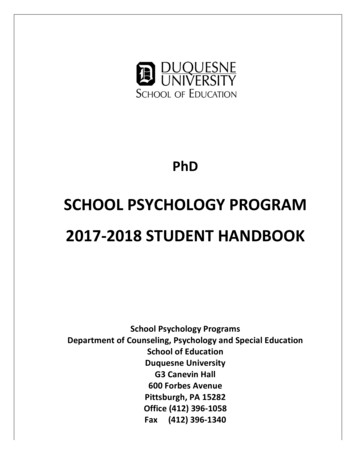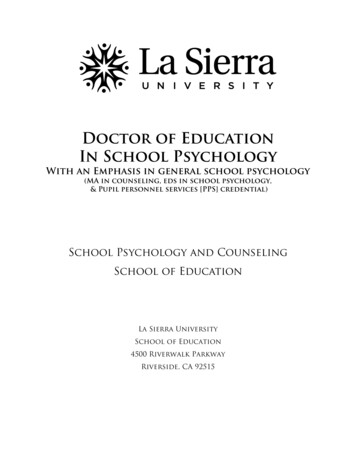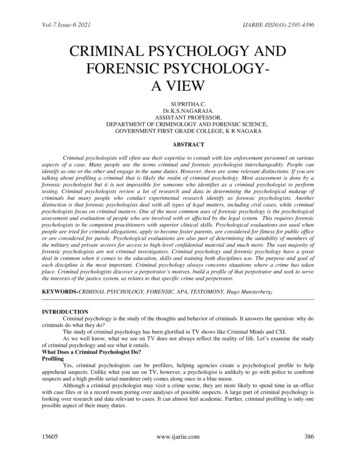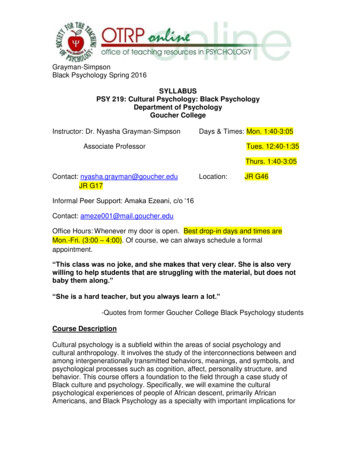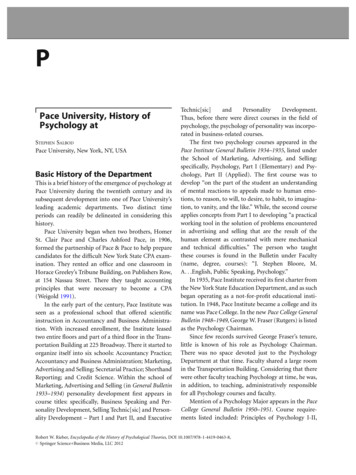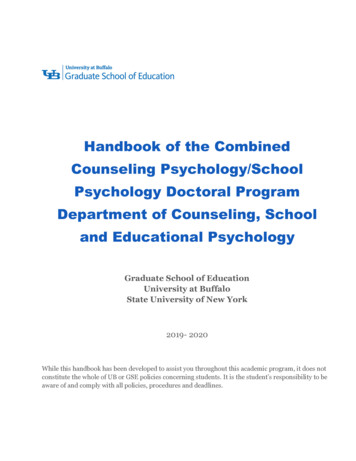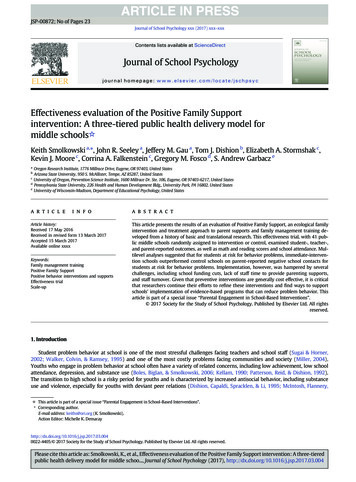
Transcription
JSP-00872; No of Pages 23Journal of School Psychology xxx (2017) xxx–xxxContents lists available at ScienceDirectJournal of School Psychologyjournal homepage: www.elsevier.com/locate/jschpsycEffectiveness evaluation of the Positive Family Supportintervention: A three-tiered public health delivery model formiddle schools Keith Smolkowski a,⁎, John R. Seeley a, Jeffery M. Gau a, Tom J. Dishion b, Elizabeth A. Stormshak c,Kevin J. Moore c, Corrina A. Falkenstein c, Gregory M. Fosco d, S. Andrew Garbacz eaOregon Research Institute, 1776 Millrace Drive, Eugene, OR 97403, United StatesArizona State University, 950 S. McAllister, Tempe, AZ 85287, United StatescUniversity of Oregon, Prevention Science Institute, 1600 Millrace Dr. Ste. 106, Eugene, OR 97403-6217, United StatesdPennsylvania State University, 226 Health and Human Development Bldg., University Park, PA 16802, United StateseUniversity of Wisconsin-Madison, Department of Educational Psychology, United Statesba r t i c l ei n f oArticle history:Received 17 May 2016Received in revised form 13 March 2017Accepted 15 March 2017Available online xxxxKeywords:Family management trainingPositive Family SupportPositive behavior interventions and supportsEffectiveness trialScale-upa b s t r a c tThis article presents the results of an evaluation of Positive Family Support, an ecological familyintervention and treatment approach to parent supports and family management training developed from a history of basic and translational research. This effectiveness trial, with 41 public middle schools randomly assigned to intervention or control, examined student-, teacher-,and parent-reported outcomes, as well as math and reading scores and school attendance. Multilevel analyses suggested that for students at risk for behavior problems, immediate-intervention schools outperformed control schools on parent-reported negative school contacts forstudents at risk for behavior problems. Implementation, however, was hampered by severalchallenges, including school funding cuts, lack of staff time to provide parenting supports,and staff turnover. Given that preventive interventions are generally cost effective, it is criticalthat researchers continue their efforts to refine these interventions and find ways to supportschools' implementation of evidence-based programs that can reduce problem behavior. Thisarticle is part of a special issue “Parental Engagement in School-Based Interventions”. 2017 Society for the Study of School Psychology. Published by Elsevier Ltd. All rightsreserved.1. IntroductionStudent problem behavior at school is one of the most stressful challenges facing teachers and school staff (Sugai & Horner,2002; Walker, Colvin, & Ramsey, 1995) and one of the most costly problems facing communities and society (Miller, 2004).Youths who engage in problem behavior at school often have a variety of related concerns, including low achievement, low schoolattendance, depression, and substance use (Boles, Biglan, & Smolkowski, 2006; Kellam, 1990; Patterson, Reid, & Dishion, 1992).The transition to high school is a risky period for youths and is characterized by increased antisocial behavior, including substanceuse and violence, especially for youths with deviant peer relations (Dishion, Capaldi, Spracklen, & Li, 1995; McIntosh, Flannery, This article is part of a special issue “Parental Engagement in School-Based Interventions”.⁎ Corresponding author.E-mail address: keiths@ori.org (K. Smolkowski).Action Editor: Michelle K. 0022-4405/ 2017 Society for the Study of School Psychology. Published by Elsevier Ltd. All rights reserved.Please cite this article as: Smolkowski, K., et al., Effectiveness evaluation of the Positive Family Support intervention: A three-tieredpublic health delivery model for middle schoo., Journal of School Psychology (2017), http://dx.doi.org/10.1016/j.jsp.2017.03.004
2K. Smolkowski et al. / Journal of School Psychology xxx (2017) xxx–xxxSugai, Braun, & Cochrane, 2008). By ninth grade, having had just one suspension doubles the chance that a student will drop outof public school (Balfanz, Byrnes, & Fox, 2013), suggesting the need for services that address problem behavior as early as middleschool. Many of the behavioral problems that define the risk trajectory for serious delinquency and early-onset substance use aremost apparent and predictable from prior behavior in the school setting and from disorganized family management practices(Dishion & Patterson, 1993; Schaeffer, Petras, Ialongo, Poduska, & Kellam, 2003). Thus, early adolescence represents a windowof opportunity to intervene with students who are currently displaying behavior problems and are prone to escalating these behaviors in adolescence.1.1. Family management interventionsResearch supports the value of parental involvement and monitoring as predictors of academic achievement (Spera, 2005) andthe need for interventions that target parenting practices for high-risk students (e.g., Stormshak, Connell, & Dishion, 2009). Familymanagement skills have an influence on the developmental pattern underlying adolescent problem behaviors (Fosco, Dishion, &Stormshak, 2012; Patterson & Dishion, 1988; Peterson, Hawkins, Abbott, & Catalano, 1994). Supportive family relationships reducethe risk of substance use and later problem behavior (Connell, Dishion, Yasui, & Kavanagh, 2007; Padilla-Walker, Nelson, Madsen,& Barry, 2008; Stormshak, Fosco, & Dishion, 2010; Szapocznik et al., 1991). Some reviews of effective interventions to reduceyouth problem behavior have revealed that family-centered treatment models have the largest effects over time (e.g., Sanders,2012; Weisz & Kazdin, 2010; but cf. McCart, Priester, Davies, & Azen, 2006).Despite the evidence of benefits, a very small percentage of parents participate in parenting or family interventions to addressbehavior problems (Prinz & Sanders, 2007; Zubrick et al., 1995). Although relatively brief parent interventions in public schoolsmay motivate positive change in parenting and reduce problem behavior (Dishion & Kavanagh, 2003; Forgatch, Bullock, &DeGarmo, 2003; Kazdin, 2002), few public middle schools integrate empirically supported mental health and parent interventionsinto their behavior management armamentarium (Atkins, Hoagwood, Kutash, & Seidman, 2010). Failure to adopt these practicesmay have been a product of multiple barriers. The costs and logistics of implementation, time needed to train school administrators or specialists to execute the intervention, inability to secure the requisite professionals for training, inability to reach parentsand provide services to families, and competing priorities limit the ability of schools to implement interventions that involve families (Forman, Olin, Hoagwood, Crowe, & Saka, 2009). As such, most interventions that target parenting practices are unrealistic forschools (Christenson, 2003). Hence, cost-effective and efficient strategies for engaging parents within school systems that offer aclearly defined set of evidence-based behavior management and academic support strategies are warranted.1.2. Positive Family Support within tiered behavioral supports in schoolsMultitiered frameworks such as positive behavioral interventions and supports (PBIS; e.g., Anderson & Kincaid, 2005; Horner,Sugai, Todd, & Lewis-Palmer, 2005) that embed services within a model of universal, selected, and indicated interventions delivered in the school (Horner, Sugai, & Anderson, 2010) provide this context for integrating family-centered interventions. PBIS focuses on positive, nonaversive, and systems-change approaches, which have been shown to reduce problem behaviors withinschool settings (e.g., Bradshaw, Mitchell, & Leaf, 2010; Horner et al., 2009; Lane, Wehby, Robertson, & Rogers, 2007; Lassen,Steele, & Sailor, 2006; Smolkowski, Strycker, & Ward, 2016; Waasdorp, Bradshaw, & Leaf, 2012; Ward & Gersten, 2013). Manyschools implement PBIS practices schoolwide, in the classroom, and when working with individual students. Common schoolwidePBIS implementations embrace a set of core principles: (a) all stakeholders share the operational set of values, beliefs, vision, mission, and purpose that shapes the climate and culture of the school and classrooms; (b) a small set of positively worded behavioral expectations can be clearly defined and actively taught; (c) appropriate behaviors are reinforced; (d) problem behaviors areviewed as an opportunity to teach, with corrections applied calmly and consistently; (e) decisions about students and systems aredriven by data about office referrals and other aspects of school functioning; and (f) administrators are an active component inthe process. Horner et al. (2010) discuss schoolwide PBIS as an educational practice and the evidence base for primary(schoolwide) interventions, as well as secondary and tertiary interventions. Schools that implement PBIS may involve individualparents or adopt specific home–school collaboration practices to support their students (Horner et al., 2010), such as sendinghome a daily behavior report card (Chafouleas, Riley-Tillman, & Sassu, 2006) or Check-In/Check-Out point cards for parents to review (Turtura, Anderson, & Boyd, 2014). Few schools integrate parent management training or other parenting supports into theirportfolio of strategies, but features of the tiered behavior support systems may serve as ideal points of entry for more intensiveparenting and family management services.The Positive Family Support (PFS) model is a school-based approach to providing a range of family management interventionsfor middle school youths and their caregivers. To improve the efficiency and uptake of evidence-based family supports, such asthe Family Check-Up (FCU; Dishion & Stormshak, 2007), the intervention model was redesigned to fit within the PBIS systemby using principles of systemic concatenation (Dishion, 2011). Systemic concatenation entails adopting the core intervention principles (see concept of kernels; Embry & Biglan, 2008) found to be effective in evidence-based programs into a delivery system thatimproves the workflow and ecology of the school environment. In systemic concatenation with the FCU model, the scope and sequence of family supports align neatly within the context of the PBIS system. Consonant with the precursor Adolescent TransitionsProgram (ATP; Dishion & Andrews, 1995), a key feature of PFS is that it is a multilevel intervention model, assessment driven, andtailored to the needs of youths and families (Dishion & Kavanagh, 2000). Fig. 1 provides an overview of the PFS model and itsintegration within the PBIS system. Universal interventions built on the PBIS structures emphasize parents' awareness of schoolPlease cite this article as: Smolkowski, K., et al., Effectiveness evaluation of the Positive Family Support intervention: A three-tieredpublic health delivery model for middle schoo., Journal of School Psychology (2017), http://dx.doi.org/10.1016/j.jsp.2017.03.004
K. Smolkowski et al. / Journal of School Psychology xxx (2017) xxx–xxx3Fig. 1. An overview of how the Positive Family Support (PFS) model integrates within positive behavior interventions and supports (PBIS). Universal interventionsbuilt on the PBIS structures emphasize parents' awareness of school expectations, promote student engagement through the family resource center, and recommend brief workshops to teachers about increasing parent engagement and teacher–parent communication. The secondary or selected level provides more intensive supports, such as a protocol for engaging parents in the Check-In/Check-Out intervention and supports to improve attendance and homework completion. Thetertiary or indicated level of supports includes the Family Check-Up, which comprises a family assessment, feedback, and menu of parenting support services, aswell as parenting support sessions, parent management training, and community referrals.expectations, promote student engagement, and recommend brief workshops to teachers about increasing parent engagementand teacher–parent communication. The selected level provides more intensive supports, such as a protocol for engaging parentsin the Check-In/Check-Out intervention and supports to improve attendance and homework completion. The indicated level ofsupports includes the FCU, which consists of a family assessment, feedback, and menu of relevant and available parenting supportservices as well as parenting support sessions, parent management training, and community referrals.This strategy allows PFS implementers to take advantage of systems typical of PBIS, such as behavior support that is among thetop school improvement goals, behavior support teams that use data for decision making, and administration support for preventive interventions. Adaptations to PFS, however, were needed to facilitate the school-based delivery of the FCU. The standard FCUmodel included videotaping family interactions, for example, which was removed from the protocol, and parent and teacher assessment ratings used to provide feedback to parents were shortened. This streamlining was intended to facilitate the completionof an FCU with parents in one or two sessions when delivered by school staff, in contrast to the minimum 3 h of contact the FCUrequired in efficacy studies (see Dishion & Stormshak, 2007). Parent management training was also shortened to include fourmodules particularly relevant to school staff, based on focus groups with school staff members: (a) positive behavior supportin the home to increase academic engagement, (b) limit setting, (c) monitoring one's adolescent, and (d) relationship buildingby negotiating solutions to conflict between parents and adolescents. PFS also included content directly related to school success,such as parenting strategies to increase homework completion and attendance support.1.3. Positive Family Support conceptual modelPFS content was based on a number of evidence-based parent management and training models, including the Parent Management Training Model (PMTO; Forgatch, Patterson, & DeGarmo, 2005), ATP, and the Everyday Parenting Curriculum (Dishion,Stormshak, & Kavanagh, 2011). The conceptual framework for the PFS model is presented in Fig. 2. As can be seen, the PFS approach is hypothesized to improve family management and academic support strategies in the home (e.g., reduced family conflict,improved student monitoring, increased parental involvement with school and their child, decreased negative school contact, increased positive school contact). Several studies support the impact of PFS practices on family management and academic supportstrategies (e.g., Fosco, Van Ryzin, Connell, & Stormshak, 2016; Irvine, Biglan, Smolkowski, Metzler, & Ary, 1999).Please cite this article as: Smolkowski, K., et al., Effectiveness evaluation of the Positive Family Support intervention: A three-tieredpublic health delivery model for middle schoo., Journal of School Psychology (2017), http://dx.doi.org/10.1016/j.jsp.2017.03.004
4K. Smolkowski et al. / Journal of School Psychology xxx (2017) xxx–xxxFig. 2. Conceptual framework for the Positive Family Support intervention.Family management and academic support strategies, in turn, are expected to have a positive impact on student social andemotional adjustment (e.g., fewer conduct and emotional problems, reduced experimentation with substances, positive interactions with peers) and improved student engagement in school (e.g., attendance, homework completion, positive attitudesabout school). Previous research has demonstrated the efficacy of the combination of primary and secondary family managementstrategies on reductions in marijuana use into early adulthood (Véronneau, Dishion, Connell, & Kavanagh, 2016). Van Ryzin andDishion (2012) found reductions in youth antisocial behavior through high school for a high-risk sample. In a replication of themultilevel FCU approach, effects were not found on reductions in student problem behavior in middle school, but complier average causal effect (CACE) analyses, which estimate a treatment effect among those families that engaged in the FCU, revealed decreases in substance use initiation, antisocial behavior, deviant peer affiliations, family conflict, and risk behavior (Fosco et al.,2012; Van Ryzin, Stormshak, & Dishion, 2012). CACE models also suggested that engagers in the FCU had less growth in depression and family conflict (Fosco et al., 2016). These social, emotional, and school engagement outcomes were then hypothesized tolead to students' success in high school (e.g., academic achievement and school completion). Another CACE model revealed improvement in school grades and attendance through high school (Stormshak et al., 2009). The results of prior research on theFCU suggest that, at least for families engaged in the FCU process, students may improve their behavioral, social, and emotionaloutcomes.1.4. An effectiveness trialIn this study we sought to evaluate the effectiveness of the PFS intervention when implemented by school personnel underroutine conditions. The study examined the impact of PFS within a cluster randomized controlled trial that randomly allocated41 Oregon public middle schools to receive the PFS intervention either immediately (n 21) or after a delay of 3 to 4 years(n 20). School staff members and administrators received training and coaching about how to prepare a family resource center(FRC) in their buildings, how to increase parent–school communication, and how to provide parents with the opportunity to participate in the FCU. In an effectiveness evaluation (Gottfredson et al., 2015) intended to test PFS in real-world settings, school personnel implemented PFS interventions with students and their families.In addition to examining student outcomes, the study also examined implementation fidelity, processes, and sustainabilitythrough a multi-stakeholder process evaluation. The blending of effectiveness and implementation research components in thisway constitutes an effectiveness–implementation hybrid design, as described by Curran, Bauer, Mittman, Pyne, and Stetler(2012), and specifically, a Hybrid Type 1 design. The process evaluation, conducted during the rollout of the PFS model, investigated the barriers and facilitators to implementation to further our understanding of treatment heterogeneity. These implementation findings have been presented in previous reports: Fosco et al. (2014) present the history of PFS, its integration within PBIS,and details about its components and implementation, including lessons learned through work with the first 21 schools.Stormshak et al. (2016) extend the work with a discussion of challenges and barriers encountered taking PFS to scale in middleschools, such as limited resources, lack of staff training on key skills, and administrator turnover. Dishion et al. (2016) discuss thethree primary barriers and potential solutions that use digital technology that may help schools provide tailored and proactiveparent support.As an effectiveness trial, the project required an evaluation by a team external to the PFS developers. The evaluation team conducted random assignment, collected all data, and conducted statistical tests for this report. The full team, including developersand interventionists, chose the measures that best represented the intervention targets that align with the conceptual frameworkpresented in Fig. 2. This approach abides by standards of evidence for effectiveness trials in prevention science research(Gottfredson et al., 2015). Specifically, we aimed to meet the desirable standard that “a researcher who is neither a current norpast member of the program developer's team should conduct data collection and analysis” (Gottfredson et al., 2015, p. 912).Please cite this article as: Smolkowski, K., et al., Effectiveness evaluation of the Positive Family Support intervention: A three-tieredpublic health delivery model for middle schoo., Journal of School Psychology (2017), http://dx.doi.org/10.1016/j.jsp.2017.03.004
K. Smolkowski et al. / Journal of School Psychology xxx (2017) xxx–xxx5Schools assigned to the immediate-intervention condition (hereafter intervention) were compared with schools assigned to thedelayed-implementation condition (hereafter control) on student- and parent-reported behavior, teacher report of school-basedfamily practices, and school archival academic outcomes. The first of two primary research questions asked whether studentsin schools provided with PFS improved on measures of constructs depicted in Fig. 2. Because well-adjusted students and wellmanaged families would not likely require the supports offered through PFS, and because the research base suggested the importance of engaging high-risk families, we hypothesized that level of risk would moderate intervention effects; that is, those students with greatest risk are most likely to participate in aspects of PFS (e.g., Stormshak et al., 2009) and be the most likely tobenefit. This also represented a primary research question.We also had several secondary questions. Because we recruited two successive cohorts of students within each school, we tested for moderation effects by cohort, but had no a priori hypothesis that one cohort would benefit more from PFS than would theother. We also tested gender and minority status as moderators, but again we had not hypothesized that the effects of PFS woulddiffer by these student characteristics (Barrera, Castro, & Biglan, 1999; Gonzales et al., 2012).2. MethodThis study was designed to test the effectiveness of the PFS intervention by using a cluster randomized controlled trial thatnests students and staff within middle schools that had implemented key features of schoolwide PBIS systems. Investigatorshad planned to recruit 40 to 44 schools that met inclusion criteria and agreed to participate, and then assign half to each oftwo conditions: immediate PFS implementation intervention or delayed implementation control. The design allowed for the detection of effect sizes (Hedges' g; Hedges, 1981) in the range of 0.30 to 0.39, with a conservative Type I error rate (α) of 0.001to account for multiple tests.2.1. Study designThe design matched the original specification, with only minor exceptions. Participating schools were enlisted into the study inthree annual recruitment waves rather than two as planned. Project staff recruited and randomized 14 schools before the 2009–2010 academic year, 13 schools before the 2010–2011 academic year, and 14 schools before the 2011–2012 academic year. Werandomly assigned schools to immediate or delayed PFS implementation within districts and matched on total enrollment. Singleschools within a district were matched with other single schools by enrollment, and in the 2010–2011 school year, one schoolwas unmatched and assigned at random condition by itself. Schools assigned to the immediate intervention condition began implementation 1 year after recruitment and randomization. Schools assigned to the delayed control condition began implementation 3 years after recruitment and randomization. Fig. 3 depicts the timeline and Fig. 4 presents a school and participant flowdiagram.Within each school, we recruited two successive cohorts of sixth grade students. Cohort 1 entered sixth grade immediatelyafter recruitment and randomization, 1 year before PFS implementation in the intervention schools. Cohort 2 began sixth gradethe next year, 1 year after recruitment and randomization and during the first implementation year in intervention schools. Within intervention schools, all students in Cohort 1 finished sixth grade before implementation, and all students in Cohort 2 begansixth grade after implementation. We followed each cohort through eighth grade, which means that students in Cohort 1 receivedFig. 3. Positive Family Support study timeline. The timeline depicts the three waves of recruitment and randomization (RR) and the intervention timing for immediate-intervention (PFS) and delay (Control) schools. Each PSF school participated in assessments only (Assess) in their first year, received training (T) and ongoingcoaching in the Positive Family Supports model before their second year of participation, and continued to implement PFS and participate in assessments thereafter. Control schools participated in only assessments during their first 3 years and then received the same training and coaching in the beginning of their fourthyear. Within each wave of schools, we followed two cohorts of students. Cohort 1 entered sixth grade during the first assessment year and exited middle school inthe third year of each wave. Cohort 2 entered sixth grade in the second year, after implementation began in PFS schools, and completed eighth grade in the fourthyear of a schools participation.Please cite this article as: Smolkowski, K., et al., Effectiveness evaluation of the Positive Family Support intervention: A three-tieredpublic health delivery model for middle schoo., Journal of School Psychology (2017), http://dx.doi.org/10.1016/j.jsp.2017.03.004
6K. Smolkowski et al. / Journal of School Psychology xxx (2017) xxx–xxxFig. 4. Number of schools approached (approximate) for participation and assigned to condition. Each arm indicates the number of schools, teachers, parents, andstudents allocated and who participated by time and recruitment wave.2 years of exposure to intervention activities and students in Cohort 2 received 2 years of exposure. The final wave of schools,however, did not complete the eighth grade assessment for Cohort 2 because of insufficient time.2.2. Participants2.2.1. SchoolsSchools with a minimum of 50 students in sixth grade that had implemented schoolwide PBIS systems were eligible for thestudy. We identified approximately 200 schools that met study inclusion criteria and contacted administrators at each of theschools with an invitation to participate in the study. After receipt of district approval, researchers made on-site presentationsand held phone conferences to describe the study to schools that had expressed interest in the study. Schools that agreed to participate in the study signed a memorandum of understanding.This effectiveness study included 41 middle schools in 27 school districts in the Pacific Northwest region of the United States.The average enrollment of participating schools ranged from 151 to 1037, with five schools considered small (b250 students), 18Please cite this article as: Smolkowski, K., et al., Effectiveness evaluation of the Positive Family Support intervention: A three-tieredpublic health delivery model for middle schoo., Journal of School Psychology (2017), http://dx.doi.org/10.1016/j.jsp.2017.03.004
K. Smolkowski et al. / Journal of School Psychology xxx (2017) xxx–xxx7considered medium (251 to 500 students), and 18 considered large (N 500 students). The proportion of students who receivedfree or reduced-price lunch ranged from 29% to 94% (median 58%). The proportion of English language learners ranged from0% to 37% (median 3%). The proportion of minority students ranged from 5% to 82% (median 28%). The average total SchoolwideEvaluation Tool (SET; Horner et al., 2004) score was 81.6 (SD 13.2), implying that the average school met implementation standards for schoolwide PBIS. Schools were found to be comparable across the two study conditions with regard to each of thesebaseline characteristics (all p-values N 0.16).2.2.2. TeachersWithin each school, we recruited teachers to provide reports about their students, contacts with parents, and related information.We targeted teachers with the most contact with students (e.g., homeroom teachers). The 653 participating teachers were most oftenmale (64%), Caucasian (93%), had a master's degree (69%), and had been teaching an average of 13.8 years (SD 8.7). Table 1 describes the teacher sample by study condition; teachers from both conditions were comparable on all characteristics (all pvalues N 0.45).2.2.3. StudentsAs described previously, this study included two cohorts of students, with 6921 in Cohort 1 and 5991 in Cohort 2. To recruitstudents, we used a passive (waiver of) consent process. The parents of 14,331 students received a letter that described the studyalong with a decline postcard they could return if a parent did not want his or her student to participate. The parents of 1419students (9.9%) returned the decline card, leaving 12,912 participating students. Students were on average age 11.9 years(SD 1.4) at their first report. About half were female (51%) and most were Caucasian (65%). A sizable proportion reportedtheir families had “just enough money to get by” (45%). Table 1 describes the student sample by study condition; studentsfrom both conditions were comparable on all characteristics (all p-values N 0.10), with the exception of report of how muchmoney their family had (p b 0.001).Table 1Teacher and student sample characteristics by treatment condition.PFS interventionTeacher sample characteristicsSample, NFemale, %Race or ethnicity,a %American Indian or Native AmericanAsianBlack or African AmericanHispanic or LatinoNative Hawaiian or Pacific IslanderWhite or CaucasianHighest degree obtained, %High school diplomaAssociatesBachelorsMastersDoctorate or law degreeYears teaching professionally, mean (SD)Years teaching at this school, mean (SD)Student sample characteristicsSample, NFemale, %Race or ethnicity,a %American Indian or Native AmericanAsianBlack or African AmericanHispanic or LatinoNative Hawaiian or Pacific IslanderWhite or CaucasianOtherHow much money does your family have? %Not enough to get byJust enough to get byWe only have worry about money for funWe never have to worry about moneyAge at first assessment, mean (SD)aDelayed .20.393.3
Effectiveness evaluation of the Positive Family Support intervention: A three-tiered public health delivery model for middle schools Keith Smolkowskia,⁎, John R. Seeley a, Jeffery M. Gaua, Tom J. Dishionb, Elizabeth A. Stormshakc, Kevin J. Moorec, Corrina A. Falkensteinc, Gregory M. Foscod, S. Andrew Garbacze a Oregon Research Institute, 1776 Millrace Drive, Eugene, OR 97403, United States
